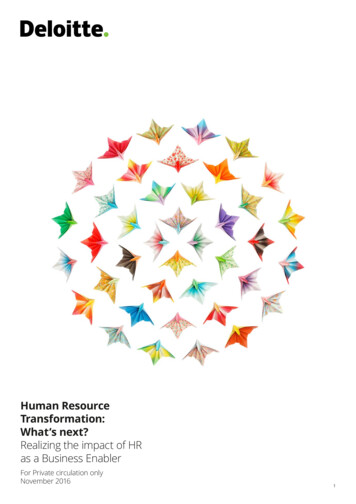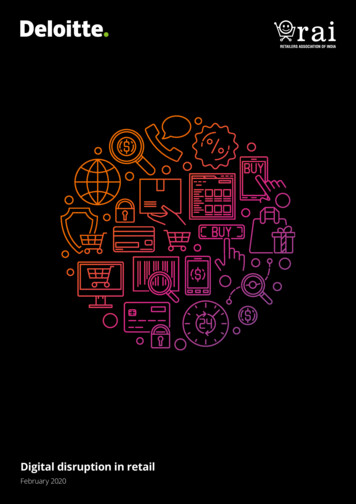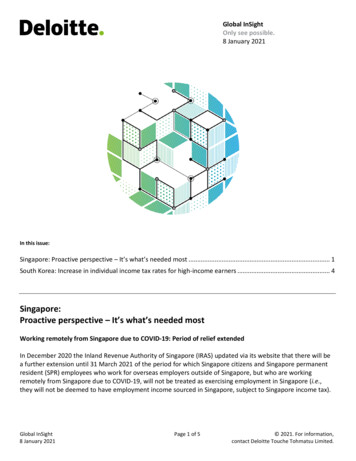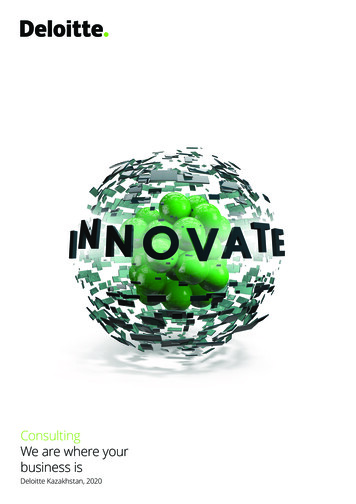
Transcription
How much disruption?Deloitte Global OutsourcingSurvey 20202020
Deloitte Global Outsourcing Survey 2020 02How much disruption?03Introduction04Outsourcing objectives and strategies06Robotic Process Automation (RPA)08Cloud10Commercials and contracts12Lessons learned14Preparing for the post-pandemic world16Let’s talk18
Deloitte Global Outsourcing Survey 2020 How much disruption?When we started planning for this 2020 survey, no oneexpected the challenges and surprises that this yearwould have in store.Our 2018 report centered on the theme of disruption, and 2020 has raised this to a newlevel. COVID-19 has been one of the most disruptive events in a generation; and the impactis still being felt, not only across the global economy but also across the huge amount ofoutsourcing relationships in place.Our biennial survey has been the cornerstone of our research into the outsourcing marketfor over a decade. This year, we adopted a more intimate approach. Instead of releasingan online survey, we interviewed 40 executives across our clients, service providers, andlawyers globally to bring a more complete perspective to our findings. The intervieweeswere spread across the Americas, Africa, Europe, Asia, and Australia, giving us a global viewof the outsourcing ecosystem. The interviews were conducted both before and after thestart of the COVID-19 pandemic, enabling us to identify how the industry has responded.We are seeing contradictions. Clients are keen to continue embracing disruptivetechnologies. Cloud and automation continue to be a driving force for change.Microsoucing continues to expand along with the ecosystem of specialized servicesproviders. However, the fallout from COVID-19 is signaling a return to basics: shoring upvalue and driving down costs, with a renewed focus on risk management.There are difficult decisions ahead. Should we continue to invest in bold ideas for majortransformational changes or invest in those capabilities that protect the business in theface of economic uncertainty? How much more disruption can we take?We have produced this report by interpreting and analyzing the insights generously sharedby our interviewees, coupled with our own extensive insights from working with clients,service providers, and lawyers over many sourcing contracts. We are always interested inseeing your take on our report and we look forward to having this discussion with you.Miles UnderwoodDeloitte Consulting AGmileunderwood@deloitte.chMike StolerDeloitte Consulting LLPmistoler@deloitte.com03
Deloitte Global Outsourcing Survey 2020 IntroductionThe outsourcing industry continues to embracedisruptive technologies, breathing new life into amature but critical driver of the economy. However, theuncertainty created by COVID-19 has instilled caution,as everyone in the industry adjusts to the disruptioncaused by the pandemic.This report provides insight into howthe latest trends in outsourcing aredramatically reshaping the industry. Inaddition to the direct takeaways from the2020 interviews, we also follow up on our2018 survey to understand whether thetrends we predicted two years ago haveactually emerged. On the whole they wereemerging before the world changed as weknew it.Four key findings emerged fromour interviewsCost reduction is back on top.In the recent past, many people in theindustry have stated that cost reductionis a secondary benefit behind otherobjectives, such as increasing agility orimproving the quality of service. This year’ssurvey shows a sharp increase in thenumber of organizations giving priority tocost reduction, and in the face of a likelypandemic-induced global recession, thisnumber will get higher.04Cloud and RPA are table stakes now.It is no surprise to see cloud and RPAsolutions as being core to most newoutsourcing transactions. In fact, asthey become more proven and familiar,they are less of a driver than two yearsago and considered “table stakes” forall transformations. Organizations arelooking for the next major technologycatalyst to power their businesstransformation efforts.Supplier management isunderpowered.Third party ecosystems are more complexthan ever, which has implications forregulatory compliance, security, risk,and data protection requirements.Organizations have rising expectationsthat service providers will spearheadtheir innovation agenda. COVID-19 hasput a severe strain on the supply chainsof organizations. All these changingdynamics have made the role of suppliermanagement more critical than ever;however, this function is still underpoweredin many organizations. Clients need toinvest more in building their suppliermanagement capabilities to manage thenew normal and achieve maximum valuefrom their service provider ecosystem.Agility is critical.Changing business scenarios, heightenedvisa restrictions, and increasing customerexpectations are all creating an imperativefor the service providers to become moreagile. Firms will now accelerate overalloutsourcing as they learn to collaboratein a world where speed, quality, flexibility,and cost are more important than physicallocation. To stay ahead in the game, serviceproviders will need to rethink how theyprovide services remotely yet effectively,build plug and play solutions that can berapidly integrated, and have contractsthat allow them to pivot as the businesssituation evolves.
Deloitte Global Outsourcing Survey 2020 05
Deloitte Global Outsourcing Survey 2020 Outsourcing objectivesand strategiesCost reduction is a primary objectiveOnly a minority (if anyone) would say thatcost is not important in an outsourcingdeal. However, in our 2018 survey, the keyobjectives of outsourcing were movingaway from reducing operating costs toenabling speed to market, scaling faster,enhancing user experience, and achievingcompetitive advantage. Now, costreduction is becoming increasingly criticalagain with over half our intervieweesindicating that cost reduction is a primaryreason for outsourcing. The impactof COVID-19 plays a key role here: theuncertain economic environment isswitching the focus back to the numbers.The providers and lawyers we interviewedtell us that cost reduction is the mainreason to outsource. While they heartheir clients talk about scalability, agility,technology enablement, and innovation,they recognize that, ultimately, clients focuson cost. Many indicated that it is easier tomeasure the impact on cost than it is toarticulate the benefits of scalability andtech enablement in a way that withstandsforensic analysis. It is therefore no surprisethat parameters like cost to achieve, ratecard, and IT investments are still heavilyweighted in the down select and finalcontract award decision. Cost may not bewhat drives a deal to the table, but dinnerisn’t over until the bill has been paid.06Outsourcing ySpeed tomarketAccess totools andprocessesAgilityCost reduction is back in vogueSource: Deloitte Global Outsourcing Survey 2020“What drives the clients’ decisions is costreduction. If there is no positive cost case,it will not happen. It is always about cost.”Partner, Law firm, EMEA
Deloitte Global Outsourcing Survey 2020 Outsourcing still seen as an enabler ofbusiness transformationAdditionally, organizations yearn forpartners that can genuinely delivera business transformation. As digitalsolutions become increasingly mainstream,clients are seeking providers who canelevate the way they do business, enablethem to be more flexible, help themleverage the latest technologies, andimprove their overall speed to market.Understanding providers’ strengthsis critical to deploying the right mix oflarge and niche providers to achieve thedesired outcomes.Service orchestration limitsstrategy implementationA flexible sourcing model with “interchangeable service providers” is nowthe mainstay for most client sourcingstrategies. This trend has been consistentover the past two years with clientsdescribing their strategies as “multi-vendor”and “multi-sourced”. Organizations are notdeterred from taking on the challenges ofintegrating these service providers, butmost note that there is “room to improvetheir orchestration capabilities” andrecognize that they are not doing enoughto manage service providers adequately.A few of the clients we talked withexpressed disappointment that providerswere not delivering the necessary value.Some of them are responding by bringingthe work back inhouse. While this approachmay work, in some cases it is a step too far.Investing in strong service orchestrationis key, as it will help ensure organizationsrealize maximum benefits from theirservice provider ecosystem, resulting incomprehensive accountability for actionand reduced value leakage. It is obviousto state that investing more in suppliermanagement will improve the controlorganizations seek; however, whilst anumber of interviewees agreed with us,many were frustrated about the abilityto secure investment, knowing well thatoutsourcing deals require multiple years ofmanagement to ensure that the businesscase promised at contract signature will stillbe delivered throughout the term.“Outsourcingas a concept ischanging frommake it run tomake changehappen.”Country Lead,Large IT outsourcing serviceprovider07
Deloitte Global Outsourcing Survey 2020 Robotic ProcessAutomation (RPA)Successful clients are pursuing RPA forreasons beyond costRPA continues to be a major driving forcein outsourcing solutions, but today'schallenges are more granular. Over 75percent of our interviewed clients areactively considering or pursuing RPA intheir sourcing arrangements. In 2018we predicted that the adoption of RPAwould continue to grow, with companiesimplementing automation solutionsthrough third party providers, Centersof Excellence (CoEs), or a combinationof the two. At that time, 72 percent ofthe organizations in the survey hadadopted or were considering RPA. Sincethen, organizations have progressedmuch further by “overcoming technologylimitations” and “improving managementawareness”.Our 2020 survey results show a clearprogression in the adoption of RPA throughoutsourcing. Our interviewees are nowfocused on solving the tactical challengesof RPA adoption, such as developing andmaintaining a positive business case,defining provider responsibilities, andassigning data ownership. This contrastswith our 2018 survey, when organizationalresistance, process fragmentation, andregulatory constraints were the biggestroadblocks to the adoption of RPA.Again, reducing costs is a key driver. Theprimary motivation seems to have shiftedwith most 2020 interviewees (two-thirds)citing cost savings as the major driverfor RPA adoption (while our 2019 SharedServices Survey showed that results hadbeen modest), whereas two years ago itwas never “top of mind”. 60% savings2%20-40% savings9% 10% savings53%10-20% savings27%Most respondents realized less than10% savings from RPA implementationSource: Deloitte Shared Services Survey 201908Creating capacity by scaling RPA isan opportunity to invest in morefulfilling jobs, more flexible workarrangements, and enhancingemployee experience.Organizations struggling todevelop a positive business caseshould expect an initial increase inoperating costs with benefitsgrowing slowly as the digitalworkforce matures.Outsourcing providers can addvalue to organizations looking toadopt RPA; strategic discussionswith providers, establishing jointownership, and putting in placeappropriate incentive mechanismsare crucial steps.Savings achieved through RPA40-60% savings9%Overcomingimplementationchallengesand buildingsmarter botsBusinesses that have successfullyimplemented simple task-basedautomation can adopt moreadvanced solutions like AI; manyorganizations are already makingsteady progress in the applicationof intelligent automation.
The road ahead for RPAAccording to the 2020 survey interviewees,the biggest barrier to RPA adoption isthe inability to capture immediate value.Some clients find it difficult to justify theinvestment as they don’t see a positivebusiness case in the short-term. However,while the current pandemic crisis makestechnology adoption an even biggerchallenge for many organizations, it offersaggressive organizations with liquidity anopportunity to implement automationprograms that transform their operatingmodels and outpace competitors lackingthe means, or the foresight, to adjust.Investments today are likely to producelarge scale benefits in the long term.RPA adoption is not just about costreduction. It can also free up the workforceto focus on more strategic issues. Doingso can lead to greater employee andcustomer satisfaction, with subsequentimprovements in enterprise value.As the popularity of RPA matures for logicalrule-based processes, the use of advancedtechnologies like Artificial Intelligence (AI)is also becoming widespread. According toDeloitte’s, “Automation with Intelligence”survey (2019), 58 percent of respondentshad already started implementingAI. There was higher acceptance andincreasing adoption of AI in companies thatwere using RPA. As maturity increases, thistrend is unstoppable as more and moreorganizations experience these benefits.“RPA and AIare helpingus becomesmarter, theyare our keyfocus for 2020.”Head of IT ApplicationsManagement,International engineeringand services companyTop challenges in RPA adoption2018 Organizational resistance Process fragmentation Regulatory constraints Developing a prositive business case Defining provider responsibilities Assigning data ownership202009
Deloitte Global Outsourcing Survey 2020 CloudStill number oneAlmost every organization interviewedclaims to be “cloud first,” but many are stillstruggling to implement the changes totheir operating model that are requiredto reap the benefits. Around 90 percentof this year’s client participants saw cloudas one of their primary enablers in theiroutsourcing journey—a similar statisticto 2018 and supported by findings fromour 2019 shared services survey. Yet, asurprising number of respondents cite “lackof maturity” either in terms of solutions oroperating models as being major barriersto realizing the full benefits, particularlyaround increasing scalability, improvingspeed to market, and reducing costs.The COVID-19 crisis will accelerate cloudadoption further as traffic is pushedoff corporate networks and into theinternet (with telco providers and networkarchitects racing to meet the challenge),and organizations are eager to shrinktheir real estate portfolios managementoverheads by relinquishing theirdata centers.Managing risks is a top priorityData security is still the most cited concernrelating to cloud services. Worries oncompliance and regulation risk havedisplaced those relating to performanceover the past two years.None of our interviewees in 2020mentioned concerns about performance,whereas almost 50 percent of therespondents raised this issue in 2018. Theefforts of both public and private cloudproviders appear to have strengthened10Top 3 digital enablers68%64%55%CloudRPASingle instanceERPAs of 2019, 68% of industry leaders had employed Cloud asone of their digital enablersSource: Deloitte Shared Services Survey 2019“Cost savings, transparency, fasterprovisioning and deployments—overall ithas been a positive cloud journey for us.”Head of IT Applications Management,International engineering and services company, EMEAcloud resilience, even if there is still theoccasional headline-grabbing outage.Commercial concerns are predominatingover technical and operational issues.Terminating without significant penaltiesremains a highly relevant issue, but moreclients are concerned about maintainingcompetitive tension and “avoiding lock-into a single supplier”. Is it agile to go all inwith a single cloud provider, or does agilityalso mean managing a broad portfolio ofcloud options?The mechanisms for risk mitigationbetween client and cloud service providerneed to be stronger. Roughly four in ten ofour interviewees articulated this need toensure they can enjoy the benefits of thecloud with peace of mind. Providers aregetting this message: almost all interviewedsuppliers indicated that improvingcloud data security was their biggestongoing focus.
Deloitte Global Outsourcing Survey 2020 “Microservices arethe new disruptivesolutions. Thoughcore processesare some timeaway from beingdisrupted, thestandard businessprocesses areseeing its adoption.”Primary concerns with cloud contracting services2018 Data security Performance and resilience Service providers' compliance with lawand regulations Data security and loss of IP Service providers' compliance with lawand regulations Commercial2020Vice President, IT outsourcingservice providerMicroservices are an architecturalpattern that structures anapplication as a collection ofloosely coupled services thatimplement business capabilities.The microservice architectureenables the continuous deliveryand deployment of large, complexapplications. This helps improveorganizations’ speed to market.Newer cloud solutions willemerge in the futureThe demand for cloud-based outsourcingis going to increase. Most interviewees inthis year’s survey plan to increase theiruse of the cloud and other disruptivetechnologies, to simplify their operatingenvironment and improve decisionmaking with “actionable data”. Therefore,as organizations embrace flexibleconsumption through both hybrid andmulti-cloud environments, and becomeincreasingly cloud-savvy, the demand forbusiness transformation capabilities can beexpected to increase.The use of traditional outsourcingsolutions will decline, driven by cloudservice providers offering microservices.These services can be switched onand off to meet demand, and whiletraditional outsourcing contracts alsoprovide some flexibility (when properlycrafted), microservices are far more so.Microservices was mentioned by about tenpercent of clients and service providers as“one for the future”. As the ability to utilizecloud solutions improves, microserviceswill play an “increasingly larger role in thelandscape,” providing end-to-end solutionstailored to a customer transformationjourney, rather than bolt-on capabilitiesthat are applied to legacy solutions.11
Deloitte Global Outsourcing Survey 2020 Commercials andcontractsContracting in an age of disruptionOutcome-based contracting is stilla distant prospect for most clients.Most of our survey participants still utilizetraditional models linked to outputs ormore simplistic models like FTEs. This isdespite a huge buzz in recent yearstowards linking charges to clients’ specificbusiness outcomes.It seems surprising that buyers have notyet abandoned a model that does so muchmore for their providers than it does forthemselves. “Implementation complexity”was cited as one of the main issues byinterviewees for inaction, as moving awayfrom simplified pricing models requiresa more complex and robust governancestructure. However, the resultingperformance improvements and costreductions should be sufficient to justifythe investment. Supporting managementtoolsets have increased capability whichwill also facilitate the transition to moresophisticated models, without the need forunrealistic investment.Modifying the pricing mechanism is astrong lever for increasing value; however,it is not the only available option, andthere is no “one size fits all” strategy.Our survey interviewees have built up to30 percent year-over-year productivityinto their provider rate cards. This is arobust mechanism to drive down costsand is widely adopted across industries.It also gives providers the flexibility tochoose from a plethora of options such asautomation, offshoring, and driving processimprovements to achieve the committedcost savings, making it a win-win forboth parties.12Trust? Only so much Only a handful of client interviewees statedtheir service providers had attained theoutsourcing had attained the outsourcingideal of strategic partner. This is astaggeringly low number considering thatstrategic partnership has been a term ofchoice for many. So, what has gone wrong?To have a partner you have to be a partner.Much of the problem has come from aninability to trust the other party – or morespecifically, for both sides to agree on whatis a beneficial level of trust. Clients stilldemand robust and detailed protections intheir contracts, which focus on managingrisk and cost. We believe that this focuswill only increase due to the repercussionsof the COVID-19 pandemic. Some serviceproviders interviewed stated that thesecontracts are prohibitive and restrictive,preventing them from operating outsidethe box and driving innovation. Both sidesdo agree, however, that a true strategicpartner is able to look at mutual benefitsbeyond cost.Furthermore, clients’ portfolios of serviceproviders are becoming more complicated,and require management comparableto looking after a portfolio of stocks.Balancing risk and return across multipledimensions requires greater investment ina robust supplier management function,as failing to invest in this critical areacan drag down the value of outsourcingarrangements for everyone. Indeed, someservice providers have characterized theirclient vendor management functionsas “chaotic” and “purely cost-focused.”Investment is often focused on operationalmanagement, whereas real benefit can bedelivered by client teams comprehendingthe specific capabilities of an individualprovider, combined with a detailedunderstanding of their own business, sothat they can “marry” effectively, whereappropriate. This doesn’t mean that goodprocurement practice is jettisoned, andthe healthy scrutiny of solutions is spared,but the cynicism about outsourcingdriven innovation must go. Establishingan enabling culture within suppliermanagement is a good place to start.“Often when ourservice providersbring innovationto us, our ITstakeholders find itdifficult to shift andwe are too slow atimplementing.”IT Sourcing Lead, EMEA
Deloitte Global Outsourcing Survey 2020 “Clients don’t need classicvendor management. Theywant vendor management thatcan understand technology,understand the start-upecosystem, help find solutionsfor the business, and manageinternal stakeholders.”Senior Vice President, Large IT outsourcing service provider13
Deloitte Global Outsourcing Survey 2020 Lessons learnedService provider selection processIn 2020, the top lesson learned is the needto spend more time on the RFP or serviceprovider selection. As this has not changedsince 2018, clearly we have to questionwhether people are really heeding thelessons from prior experiences!It may help to put it in context. The industryis trying to address two competing needs:getting the details right and the need forspeed. With new disruptive solutions inthe market, the task of systematicallyselecting providers is increasingly complex,requiring long RFP processes withproviders to craft customized solutions.But the need to get the details right runscounter to the need for speed, since one ofthe most important design principles ina rapidly changing business environmentis to outpace competitors.These two demands are in conflict.Ultimately, faster contracting mechanismswill emerge because the market willdemand them. The industry will adoptand standardize solutions and contractsto speed up the process. However, noone advocates skimping on due diligence.In fact, both the service providers andlawyers we interviewed said that a shortercontracting process “creates unnecessaryrisk” by curtailing due diligence, which leadsto downstream issues later on.14Top lessons learned in outsourcing2018 Spend more time in service providerselection process Use competetive bidding process Increase scope of outsourcing services Spend more time in service providerselection process Improve change management Have shorter and flexible contractsChange managementNewly announced outsourcing journeysdon’t tend to win many hearts and minds.So it is perhaps no surprise that manyinterviewees in 2020 suggested thatthey would like to spend more time andeffort during the outsourcing process onchange management. Change is inherentlyunsettling, and keeping employeeshonestly informed from the beginninghelps smooth the transition, saving thecompany time, resources, and reputation,especially as employees may still have anegative perception of outsourcing. Tomake changes with minimal disruption tothe business and its people, intervieweesplan to focus more of their efforts oncommunication and getting people readyfor the change.2020Shorter contracts, more flexibilityEveryone wants more flexible and shortercontracts. Almost half of the lawyers weinterviewed indicated that one of themost significant learnings for the futurewas to push for shorter and more flexiblecontracts – a theme that had wide supportacross both client and service providerinterviewees. As organizations embraceagility and disruption, outsourcingcontracts must facilitate these philosophiesand be structured to recognize theincreased commoditization of theservices provided.
Deloitte Global Outsourcing Survey 2020 “We should have spentmore time in getting people(our employees) ready forthe change.”CIO, Large US manufacturing company15
Deloitte Global Outsourcing Survey 2020 Preparing for thepost-pandemic worldWe cannot ignore the impact of one of the most significant globalevents in decades, so in this final section we have drawn out a fewspecific observations about the COVID-19 pandemic.Businesses are already grappling with theconcept of a “new normal” – a term that,although overused, is an apt description ofthe way that businesses and employees willchange their ways of working. The agilitywith which organizations respond andadapt to the new normal will determinewho will fall behind and who will thrive inthe post-pandemic world.Outsourcing decisions will play a significantlymore strategic role in short-term resilienceand long-term growth. However, theoutsourcing industry itself is not unaffectedby the pandemic, and providers are alsohaving to adapt quickly to new ways ofworking. The impact has been greater onbusiness process outsourcing (BPO) thanon information technology outsourcing(ITO). This is largely due to the regulatorylimitations on the extent of virtualworkforces, rendering BPO firms underprepared. Indeed, we have heard successstories from both clients and serviceproviders about how they have helpedeach other address the immediate issuesof lockdown, such as mobilizing their ownindividual supply chains to obtain laptops foreach other.From our interviews and own insights, weanticipate the following three changes willtake shape across the outsourcing industry.Building resilienceBusiness Continuity (BC) has become acritical issue, and few contracts will containadequate provisions for another globallock-down.16While current business continuityplans in outsourcing contracts providemitigation for regional disaster scenarios,few (if any) plans would have factoreda scenario in which the whole worldcomes to a standstill. COVID-19 was ablack swan event that took BC plannersby surprise, highlighted gaps in the levelof preparedness, and tested the limits ofimagination for everyone. BC planning isnow evolving rapidly to cover future globalpandemic scenarios and will include testingof service providers’ ability to deliver fromhome offices and maintain their ownsupply chains, while delivering desired datasecurity and work productivity.Accelerating cloud adoptionThe cloud model has never lookedso attractive. It is tailored well to thecircumstances that organizations findthemselves in today. For industries liketravel and hospitality, demand is at anall-time low while the customer base ofmany streaming service providers is hittingall-time highs. Organizations that havemigrated their functions and processesto the cloud will be in a better position toscale their technology resources with thechanging demand, not only to pay whatthey need, but also to provide technologyresources required to meet that demand.They will also be in a better position toreturn quickly to “normal” and adjust theirtechnology footprint once the pandemichas subsided. Increasingly, organizationsare experiencing, first-hand, the flexibilitythat the cloud offers, and are likelyto accelerate their journey to morecloud enablement.Increase in outsourcingCOVID-19 has banished the idea thatphysical co-location of resourcesis necessary to develop a trustingrelationship in the workplace. This was a(sometimes misguided) “major inhibitor” inmany outsourcing transactions. Providers’offshore and nearshore resources havealways been considered “outsiders.” But asthe crisis imposes a remote working modelon these firms, the nature of workplacerelationships as we know them todayis changing drastically. Organizations arebecoming increasingly comfortable withhiring through virtual interview meetings,signing new contracts without a formalhandshake, replacing onsite workshopswith online sessions, and celebratingproject successes over a virtual cocktailparty or apéro. A remote work cultureis being ingrained gradually withincompanies, and this will help them accessglobal talent from the most cost-effectivelocations. It would also allow companiesto hedge their risks by diversifying theirdelivery locations. Also, with the globaleconomy expected to contract, firms are“looking at ways to preserve cash.” All thesedevelopments suggest that the needle willbe tilting more towards outsourcing.Outsourcing remains an essential toolfor client organizations to support theirstrategic goals. Requirements constantlyevolve (even more so due to the COVID-19pandemic) and the industry continues tosupport with both established and newsolutions. As always, benefitting relies ona client’s preparedness to invest beingmet by the service provider’s willingness toembrace flexibility.
Deloitte Global Outsourcing Su
the organizations in the survey had adopted or were considering RPA. Since then, organizations have progressed much further by "overcoming technology limitations" and "improving management awareness." Robotic Process Automation (RPA) Our 2020 survey results show a clear progression in the adoption of RPA through outsourcing.










